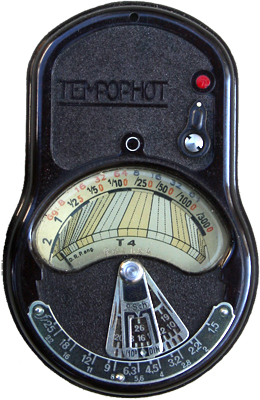
|
  Maker: Metrawatt Model: Tempophot T-4 Circa: 1934 Designers: A. Bernhard and G. Beyrich US Patent #s: 2,129,114; 2,147,961 and 2,150,047 Cell type: Selenium Measure type: Reflecting/Averaging |
|
This is one of the most interesting meters I've seen. It's from Metrawatt and it's the forerunner to their Horvex. They look a lot alike. The major difference between them is that this one is laid out similar to the Weston Masters: it's meant to be held at eye-level and the selenium cell is on the back (hence the hunchback), while the Horvex has the cell on the leading edge and is held waist-level. The good part of about the eye-level layout is that you get a big cell and it gathers a lot of light, which makes it more sensitive in low-light conditions. The bad part is that it's easy to hold it in your hand with your fingers across the cell, which will give you a bad reading. The Westons were held sideways and always shown with the fingers holding it by the edges, so that you don't obscure the cell. But in the picture above, it's being held upright. The fingers are below the cell, but you can see how easy it would be to screw things up. The other thing which really makes it nifty is that little lever switch at the top right. When it's pointed at the black dot, you read the black numbers on the scale (2 seconds, 1 second, 1/2, 1/5th, 1/10th, 1/25th, 1/50th, 1/100th, 1/300th respectively). When it's on pointed to the red dot, you read both the red and black numbers on the scale (1/25th, 1/50th, 1/100th, 1/250th, 1/500t, 1/1000th, 1/3000th respectively). Like the Gossen Ombrux, this one has a little resistor shunt which changes how the meter reacts to high and low light levels. If you're off the scale on black, you flip to red, and vice-versa. It's a very clean and simple design. American meters typically used some sort of mechanical baffle to physically reduce the light. The last little bit of niftiness is how the calculator dial works. You set the film speed (DIN or European Scheiner) on that slider, and then as you rotate it, the outer dial inside the meter window rotates with it. In this case the slider is set to f /4.5, and the needle would point to the shutter speed to use. Or you could do it backward: turn the dial so that the meter points to the shutter speed you want to use, and then read what your slider is aimed at. As I mentioned at the beginning, there are a number of minor versions of these, and it's tough to keep them straight. This one is a T4 (it's printed on the meter face, bottom center), which is supposed to be two-stops more sensitive than the original (no model) edition. The T8 version is supposedly one stop faster than this one. |
|
©opyright by James Ollinger. All Rights Reserved.
Company names and models are registered trademarks of their respective owners
and are not affiliated with this website in any way.

.jpg)